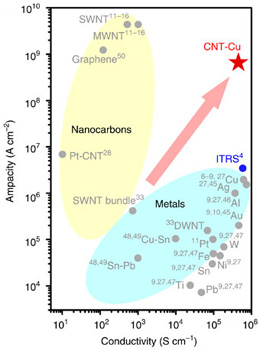Research Abstract
カーボンナノチューブ銅複合材料における電流容量の100倍増大
One hundred fold increase in current carrying capacity in a carbon nanotube–copper composite
2013年7月23日 Nature Communications 4 : 2202 doi: 10.1038/ncomms3202

電子デバイスの携帯性、汎用性、利便性の向上は、継続的な小型化の結果であり、局所領域に電流を流す必要がある。今日のデバイスは、銅や金などの導電体の最大電流容量(つまり許容電流)に近いところで動作しているため、寿命や性能が低下し、より許容電流の大きい新たな電気伝導体が必要になっている。許容電流は、物体の最大電流容量に相当し、その構造と材料の両方に依存する。今回我々は、銅(5.8×105 S cm-1)と同程度の電気伝導度(2.3~4.7×105 S cm-1)を示し、許容電流が100倍大きい(6×108 A cm-2)カーボンナノチューブ銅複合材料について報告する。真空実験によって、カーボンナノチューブ銅複合材料における銅の拡散活性化エネルギーの増大(約2.0 eV)が観測されたことから、カーボンナノチューブは銅の主要損傷経路を抑制することが実証され、これによって大きな許容電流が説明される。この材料は、高い導電率と大きな許容電流の両方を持つ唯一の材料であり、マイクロスケールの電子機器やインバーターにおける応用に比類なく適している。
Chandramouli Subramaniam1, 山田 健郎1, 2, 小橋 和文1, 2, 関口 貴子2, 二葉 ドン1, 2, 湯村 守雄1, 2 & 畠 賢治1, 2, 3
- 技術研究組合 単層CNT融合新材料研究開発機構(TASC)
- 独立行政法人産業技術総合研究所(AIST)
- 独立行政法人科学技術振興機構(JST)
Increased portability, versatility and ubiquity of electronics devices are a result of their progressive miniaturization, requiring current flow through narrow channels. Present-day devices operate close to the maximum current-carrying-capacity (that is, ampacity) of conductors (such as copper and gold), leading to decreased lifetime and performance, creating demand for new conductors with higher ampacity. Ampacity represents the maximum current-carrying capacity of the object that depends both on the structure and material. Here we report a carbon nanotube–copper composite exhibiting similar conductivity (2.3–4.7 × 105 S cm−1) as copper (5.8 × 105 S cm−1), but with a 100-times higher ampacity (6 × 108 A cm−2). Vacuum experiments demonstrate that carbon nanotubes suppress the primary failure pathways in copper as observed by the increased copper diffusion activation energy (~2.0 eV) in carbon nanotube–copper composite, explaining its higher ampacity. This is the only material with both high conductivity and high ampacity, making it uniquely suited for applications in microscale electronics and inverters.

